Indoor Air Quality Levels in Schools: Role of Student Activities and No Activities
Abstract
1. Introduction
2. Experiments
2.1. Operating Protocol
- VOCs by sampling using passive Radiello® (AMS Analitica, Pesaro, Italy) samplers and quantitative gas chromatographic determination;
- NO2 by sampling using passive Radiello® samplers and gas chromatography determination;
- Particulate matter (PM2.5) by means of direct reading analyzers (mod. DustTrak) (TSI, Shoreview, MN, USA) [34];
- CO2, humidity, temperature, and air speed by means of a q-track analyzer (TSI).
2.2. School Buildings to Be Monitored
2.3. Classroom Withdrawals for VOC and NO2
- 1 + 1 Radiello® must cover the timetable of school activities (i.e., 7:00–14:00),
- 1 + 1 Radiello® must cover the non-activity time (i.e., 14:00–7:00),
- 1 + 1 Radiello® must cover the whole day.
2.4. The Chemiometric Approach
3. Results
4. Discussion
4.1. IAQ: Gaseous/Airborne Pollutants and Denuders
4.2. A Chemometric Approach
- cluster #1 is composed of three elements: formaldehyde outdoor, NO2 indoor during activity and toluene indoor during no-activity;
- cluster #2 is composed of three elements: formaldehyde indoor during activity, formaldehyde indoor during no-activity, NO2 indoor during no-activity;
- cluster #3 is composed of four elements: xylenes outdoor, xylenes indoor during no-activity, toluene outdoor, toluene indoor during activity.
- cluster #4 is composed of seven elements: benzene outdoor, benzene indoor during activity, benzene indoor during no-activity, xylenes indoor during activity, ethylbenzene outdoor, ethylbenzene indoor during activity, ethylbenzene indoor during no-activity.
- cluster #5 is composed of one element: NO2 outdoor.
5. Conclusions
- to understand the close relationship between the school environment, health and indoor air pollution in the heterogeneous school context, through the acquisition of data on chemical pollutants;
- to stimulate the correct choice and use of energy efficient processes;
- to understand the need for regular air exchange;
- to modernize classrooms, specialized didactic laboratories, gyms, offices, etc.;
- to provide furnishings that are increasingly suitable for teaching;
- to choose educational and consumer materials taking into account the emission levels of pollutants of the individual materials.
Author Contributions
Funding
Acknowledgments
Conflicts of Interest
References
- Leech, J.A.; Nelson, W.C.; Burnett, R.T.; Aaron, S.; Raizenne, A.M.E. It’s about time: A comparison of Canadian and American time-activity patterns. J. Expo. Sci. Environ. Epidemiol. 2002, 12, 427–432. [Google Scholar] [CrossRef]
- WHO. Household Air Pollution and Health; WHO: Geneva, Switzerland, 2017; Available online: https://www.who.int/en/news-room/fact-sheets/detail/household-air-pollution-and-health (accessed on 29 June 2020).
- Ekmekcioglu, D.; Keskin, S.S. Characterization of indoor air particulate matter in selected elementary schools in Istanbul, Turkey. Indoor Built Environ. 2007, 16, 169–176. [Google Scholar] [CrossRef]
- Kumar, P.; Imam, B. Footprints of air pollution and changing environment on the sustainability of built infrastructure. Sci. Total Environ. 2013, 444, 85–101. [Google Scholar] [CrossRef] [PubMed]
- Platts-Mills, T.A. The role of indoor allergens in chronic allergic disease. J. Allergy Clin. Immunol. 2007, 119, 297–302. [Google Scholar] [CrossRef]
- Cattani, G.; Cusano, M.C.; Inglessis, M.; Settimo, G.; Stacchini, G.; Ziemacki, G.; Marconi, A. Particulate matter measurements PM2.5 and PM10 in Rome: Comparison indoor/outdoor. Ann. Ist. Sup. San. 2003, 39, 357–364. [Google Scholar]
- Costabile, F.; Alas, H.; Aufderheide, M.; Avino, P.; Amato, F.; Argentini, S.; Barnaba, F.; Berico, M.; Bernardoni, V.; Biondi, R.; et al. First results of the “Carbonaceous Aerosol in Rome and Environs (CARE)” experiment: Beyond current standards for PM10. Atmosphere 2017, 8, 249. [Google Scholar] [CrossRef]
- Manigrasso, M.; Vitali, M.; Protano, C.; Avino, P. Temporal evolution of ultrafine particles and of alveolar deposited surface area from main indoor combustion and non-combustion sources in a model room. Sci. Total Environ. 2017, 598, 1015–1026. [Google Scholar] [CrossRef]
- Settimo, G.; Manigrasso, M.; Avino, P. Indoor Air Quality: A Focus on the European Legislation and State-of-the-Art Research in Italy. Atmosphere 2020, 11, 370. [Google Scholar] [CrossRef]
- Settimo, G.; Soggiu, M.E.; Inglessis, M.; Manigrasso, M.; Avino, P. Submicron and ultrafine particles in downtown Rome: How the different euro engines have influenced their behavior for two decades. Atmosphere 2020, 11, 894. [Google Scholar] [CrossRef]
- Smith, K.R.; Samet, J.M.; Romieu, I.; Bruce, N. Indoor air pollution in developing countries and acute lower respiratory infections in children. Thorax 2000, 55, 518–532. [Google Scholar] [CrossRef]
- Ceylan, E.; Kocyigit, A.; Gencer, M.; Aksoy, N.; Selek, S. Increased DNA damage in patients with chronic obstructive pulmonary disease who had once smoked or been exposed to biomass. Respir. Med. 2006, 100, 1270–1276. [Google Scholar] [CrossRef] [PubMed]
- Kim, K.-H.; Jahan, S.A.; Kabir, E. A review of diseases associated with household air pollution due to the use of biomass fuels. J. Hazard. Mater. 2011, 192, 425–431. [Google Scholar] [CrossRef] [PubMed]
- Miller, M.R.; Shaw, C.A.; Langrish, J.P. From particles to patients: Oxidative stress and the cardiovascular effects of air pollution. Future Cardiol. 2012, 8, 577–602. [Google Scholar] [CrossRef] [PubMed]
- Tirler, W.; Settimo, G. Incense, sparklers and cigarettes are significant contributors to indoor benzene and particle levels. Ann. Ist. Sup. San. 2015, 51, 28–33. [Google Scholar]
- Gualtieri, M.; Grollino, M.G.; Consales, C.; Costabile, F.; Manigrasso, M.; Avino, P.; Aufderheide, M.; Cordelli, E.; Di Liberto, L.; Petralia, E.; et al. Is it the time to study air pollution effects under environmental conditions? A case study to support the shift of in vitro toxicology from the bench to the field. Chemosphere 2018, 207, 552–564. [Google Scholar] [CrossRef]
- Pacitto, A.; Stabile, L.; Viana, M.; Scungio, M.; Reche, C.; Querol, X.; Alastuey, A.; Rivas, I.; Álvarez-Pedrerol, M.; Sunyer, J.; et al. Particle-related exposure, dose and lung cancer risk of primary school children in two European countries. Sci. Total Environ. 2018, 616–617, 720–729. [Google Scholar] [CrossRef]
- Manigrasso, M.; Simonetti, G.; Astolfi, M.L.; Perrino, C.; Canepari, S.; Protano, C.; Antonucci, A.; Avino, P.; Vitali, M. Oxidative potential associated with urban aerosol deposited into the respiratory system and relevant elemental and ionic fraction contributions. Atmosphere 2020, 11, 6. [Google Scholar] [CrossRef]
- Pacitto, A.; Amato, F.; Moreno, T.; Pandolfi, M.; Fonseca, A.; Mazaheri, M.; Stabile, L.; Buonanno, G.; Querol, X. Effect of ventilation strategies and air purifiers on the children’s exposure to airborne particles and gaseous pollutants in school gyms. Sci. Total Environ. 2020, 712, 135673. [Google Scholar] [CrossRef]
- Pacitto, A.; Stabile, L.; Russo, S.; Buonanno, G. Exposure to submicron particles and estimation of the dose received by children in school and non-school environments. Atmosphere 2020, 11, 485. [Google Scholar] [CrossRef]
- Bennett, W.D.; Herbst, M.; Alexis, N.E.; Zeman, K.L.; Wu, J.; Hernandez, M.L.; Peden, D.B. Effect of inhaled dust mite allergen on regional particle deposition and mucociliary clearance in allergic asthmatics. Clin. Exp. Allergy 2011, 41, 1719–1728. [Google Scholar] [CrossRef]
- Fsadni, P.; Montefort, S. School indoor air quality and allergen exposure. Malta Med. J. 2013, 25, 9–13. [Google Scholar]
- Krop, E.J.M.; Jacobs, J.H.; Sander, I.; Raulf-Heimsoth, M.; Heederik, D.J.J. Allergens and β-glucans in Dutch homes and schools: Characterizing airborne levels. PLoS ONE 2014, 9, e88871. [Google Scholar] [CrossRef] [PubMed]
- Peng, Z.; Deng, W.; Tenorio, R. Investigation of indoor air quality and the identification of influential factors at primary schools in the north of china. Sustainability 2017, 9, 1180. [Google Scholar] [CrossRef]
- Slezakova, K.; de Oliveira Fernandes, E.; Pereira, M.C. Assessment of ultrafine particles in primary schools: Emphasis on different indoor microenvironments. Environ. Pollut. 2019, 246, 885–895. [Google Scholar] [CrossRef] [PubMed]
- Aversa, P.; Settimo, G.; Gorgoglione, M.; Bucci, E.; Padula, G.; de Marco, A. Case study of indoor air quality in a classroom by comparing passive and continuous monitoring. Environ. Eng. Manag. J. 2019, 18, 2107–2115. [Google Scholar]
- Simoni, M.; Annesi-Maesano, I.; Sigsgaard, T.; Norback, D.; Wieslander, G.; Nystad, W.; Canciani, M.; Sestini, P.; Viegi, G. School air quality related to dry cough, rhinitis and nasal patency in children. Eur. Respir. J. 2010, 35, 742–749. [Google Scholar] [CrossRef]
- Final report of the Schools Indoor Pollution & Health Observatory Network in Europe (SINPHONIE). Available online: https://publications.jrc.ec.europa.eu/repository/bitstream/JRC91160/lbna26738enn.pdf (accessed on 15 May 2020).
- Zauli Sajani, S.; Colaiacomo, E.; De Maio, F.; Lauriola, P.; Sinisi, L. Gruppo SEARCH. School environment and children respiratory health: The SEARCH project. Epidemiol. Prev. 2009, 33, 239–241. [Google Scholar]
- Project Indoor and outdoor Air quality and Respiratory Health in Malta and Sicily. Available online: https://keep.eu/projects/13811/ (accessed on 15 May 2020).
- Piazza, S.; Gulino, A.; Pulvirenti, S.; Vercelli, F.; Carrer, P. Assessment of indoor school environment and identification of measures to protect the respiratory health of school children and adolescents” in a sample of schools in Milan. Giornale Italiano di Medicina del Lavoro ed Ergonomia 2012, 34, 733–736. [Google Scholar]
- Agreement, Pursuant to Article 9 of Legislative Decree n. 281 of August 27, 1997, Between the Government, Regions, Autonomous Provinces of Trento and Bolzano, Provinces, Municipalities and Mountain Communities Concerning “Guidelines for the Prevention of Indoor Risk Factors for Allergies and Asthma in Schools” (in G.U. General Series no. 9 of 13-01-2011). Available online: https://www.normattiva.it/uri-res/N2Ls?urn:nir:stato:decreto.legislativo:1997-08-28;281 (accessed on 20 January 2020).
- D’Alessandro, D.; Arletti, S.; Azara, A.; Buffoli, M.; Capasso, L.; Cappuccitti, A.; Casuccio, A.; Cecchini, A.; Costa, G.; De Martino, A.M.; et al. Strategies for disease prevention and health promotion in urban areas: The Erice 50 Charter. Annali di Igiene Medicina Preventiva e di Comunita 2017, 29, 481–493. [Google Scholar]
- Manigrasso, M.; Natale, C.; Vitali, M.; Protano, C.; Avino, P. Pedestrians in traffic environments: Ultrafine particle respiratory doses. Int. J. Environ. Res. Public Health 2017, 14, 288. [Google Scholar] [CrossRef]
- Febo, A.; Perrino, C.; Cortiello, M. A denuder technique for the measurement of nitrous acid in urban atmospheres. Atmos. Environ. 1993, 27, 1721–1728. [Google Scholar] [CrossRef]
- Plaisance, H.; Leonardis, T.; Gerboles, M. Assessment of uncertainty of benzene measurements by Radiello diffusive sampler. Atmos. Environ. 2008, 42, 2555–2568. [Google Scholar] [CrossRef]
- Vassura, I.; Venturini, E.; Bernardi, E.; Passarini, F.; Settimo, G. Assessment of indoor pollution in a school environment through both passive and continuous samplings. Environ. Eng. Manag. J. 2015, 14, 1761–1770. [Google Scholar]
- Comité Européen de Normalisation. EN 838:1995: Workplace Atmospheres—Diffusive Samplers for the Determination of Gases and Vapours—Requirements and Test Methods; Comité Européen de Normalisation: Brussels, Belgium, 1995. [Google Scholar]
- Tanagra. Available online: https://eric.univ-lyon2.fr/~ricco/tanagra/en/tanagra.html (accessed on 10 June 2020).
- Avino, P.; Capannesi, G.; Manigrasso, M.; Sabbioni, E.; Rosada, A. Element assessment in whole blood, serum and urine of three Italian healthy sub-populations by INAA. Microchem. J. 2011, 99, 548–555. [Google Scholar] [CrossRef]
- Avino, P.; Capannesi, G.; Renzi, L.; Rosada, A. Instrumental neutron activation analysis and statistical approach for determining baseline values of essential and toxic elements in hairs of high school students. Ecotoxicol. Environ. Saf. 2013, 92, 206–214. [Google Scholar] [CrossRef]
- Manini, P.; De Palma, G.; Andreoli, R.; Poli, D.; Mozzoni, P.; Folesani, G.; Mutti, A.; Apostoli, P. Environmental and biological monitoring of benzene exposure in a cohort of Italian taxi drivers. Toxicol. Lett. 2006, 167, 142–151. [Google Scholar] [CrossRef] [PubMed]
- Simon, V.; Borownjack, C.; Touya, C. Benzene, toluene and xylene measurements in the vicinity of petrol stations (Toulouse—France). In Urban Transport XII; Brebbia, C.A., Ed.; WIT: WIT Press Sales: Ashurt Lodge, UK, 2006; Volume 89, pp. 663–668. [Google Scholar]
- Allou, L.; Marchand, C.; Mirabel, P.; Le Calvé, S. Aldehydes and BTEX measurements and exposures in university libraries in Strasbourg (France). Indoor Built Environ. 2008, 17, 138–145. [Google Scholar] [CrossRef]
- Woolf, A. A 4-year-old girl with manifestations of multiple chemical sensitivities. Environ. Health Perspect. 2000, 108, 1219–1223. [Google Scholar] [CrossRef]
- Stabile, L.; De Luca, G.; Pacitto, A.; Morawska, L.; Avino, P.; Buonanno, G. Ultrafine particle emission from floor cleaning products. Indoor Air 2020, in press. [Google Scholar] [CrossRef]
- Settimo, G.; Turrio Baldassarri, L.; Brini, S.; Lepore, A.; Moricci, F.; de Martino, A.; Musmeci, L.C.L.; Nania, M.A.; Costamagna, F.; Marcello, I.; et al. Presence of CO2 and H2S in indoor environments: Current knowledge and scientific field literature. Rapp. ISTISAN 16/15 2016, VI, 30. (In Italian) [Google Scholar]
- Health Council of the Netherlands. Indoor Air Quality in Primary Schools and The Value of Carbon Dioxide as an Indicator of Air Quality; publication no. 2010/06E; Health Council of the Netherlands: Hague, The Netherlands, 2010.
- Ministérios Do Ambiente, Ordenamento Do Território E Energia, Da Saúde E Da Solidariedade, Emprego E Segurança Social. Diário da República; 1.a série -N.o 235-4 de dezembro de Lisbom, Ministérios Do Ambiente, Ordenamento Do Território E Energia, Da Saúde E Da Solidariedade, Emprego E Segurança Social: Lisbon, Portugal, 2013. [Google Scholar]
- Department for Education and Employment. Guidelines for Environmental Design in Schools; (Revision of Design Note 17); Department for Education and Employment: London, UK, 1997.
- Minister of Supply and Services. Exposure Guidelines for Residential Indoor Air Quality; Minister of Supply and Services: Ottawa, QC, Canada, 1995.
- Patterson, E.; Eatough, D.J. Indoor/Outdoor relationships for ambient PM2.5 and associated pollutants: Epidemiological implications in Lindon, Utah. J. Air Waste Manag. Assoc. 2000, 50, 103–110. [Google Scholar] [CrossRef] [PubMed][Green Version]
- Missia, D.A.; Tolis, E.I.; Karanikolas, D.; Kosmidis, C.; Markou, A.; Mavrovouniotou, S.; Bartzis, J.G. Volatile organic compounds measurements at schools in Kozani, Greece. Environ. Sci. Eng. 2009, 203–214. [Google Scholar]
- Kovacs, M.H.; Roba, C.; Roşu, C.; Neamţiu, I.; Gurzău, E. Assessment of air quality from primary school classrooms and the presence of volatile organic compounds (VOCs). Carpathian J. Earth Environ. Sci. 2013, 8, 55–61. [Google Scholar]
- Rella, R.; Sturaro, A.; Vianello, A. Incorrect installation and use of materials as the cause of a severe air pollution incident in a school building. Sci. Total Environ. 2014, 487, 255–259. [Google Scholar] [CrossRef] [PubMed]
- Olufemi, A.C.; Mji, A.; Mukhola, M.S. Health risks of exposure to air pollutants among students in schools in the vicinities of coal mines. Energy Explor. Exploit. 2019, 37, 1638–1656. [Google Scholar] [CrossRef]
- Papaefstathiou, E.; Bezantakos, S.; Stylianou, M.; Biskos, G.; Agapiou, A. Comparison of particle size distributions and volatile organic compounds exhaled by e-cigarette and cigarette users. J. Aerosol Sci. 2020, 141, 105487. [Google Scholar] [CrossRef]
- Brocco, D.; Fratarcangeli, R.; Lepore, L.; Petricca, M.; Ventrone, I. Determination of aromatic hydrocarbons in urban air of Rome. Atmos. Environ. 1997, 31, 557–566. [Google Scholar] [CrossRef]
- Avino, P.; Manigrasso, M. Ten-year measurements of gaseous pollutants in urban air by an open-path analyzer. Atmos. Environ. 2008, 42, 4138–4148. [Google Scholar] [CrossRef]
- Monod, A.; Sive, B.C.; Avino, P.; Chen, T.; Blake, D.R.; Rowland, F.S. Monoaromatic compounds in ambient air of various cities: A focus on correlations between the xylenes and ethylbenzene. Atmos. Environ. 2001, 35, 135–149. [Google Scholar] [CrossRef]
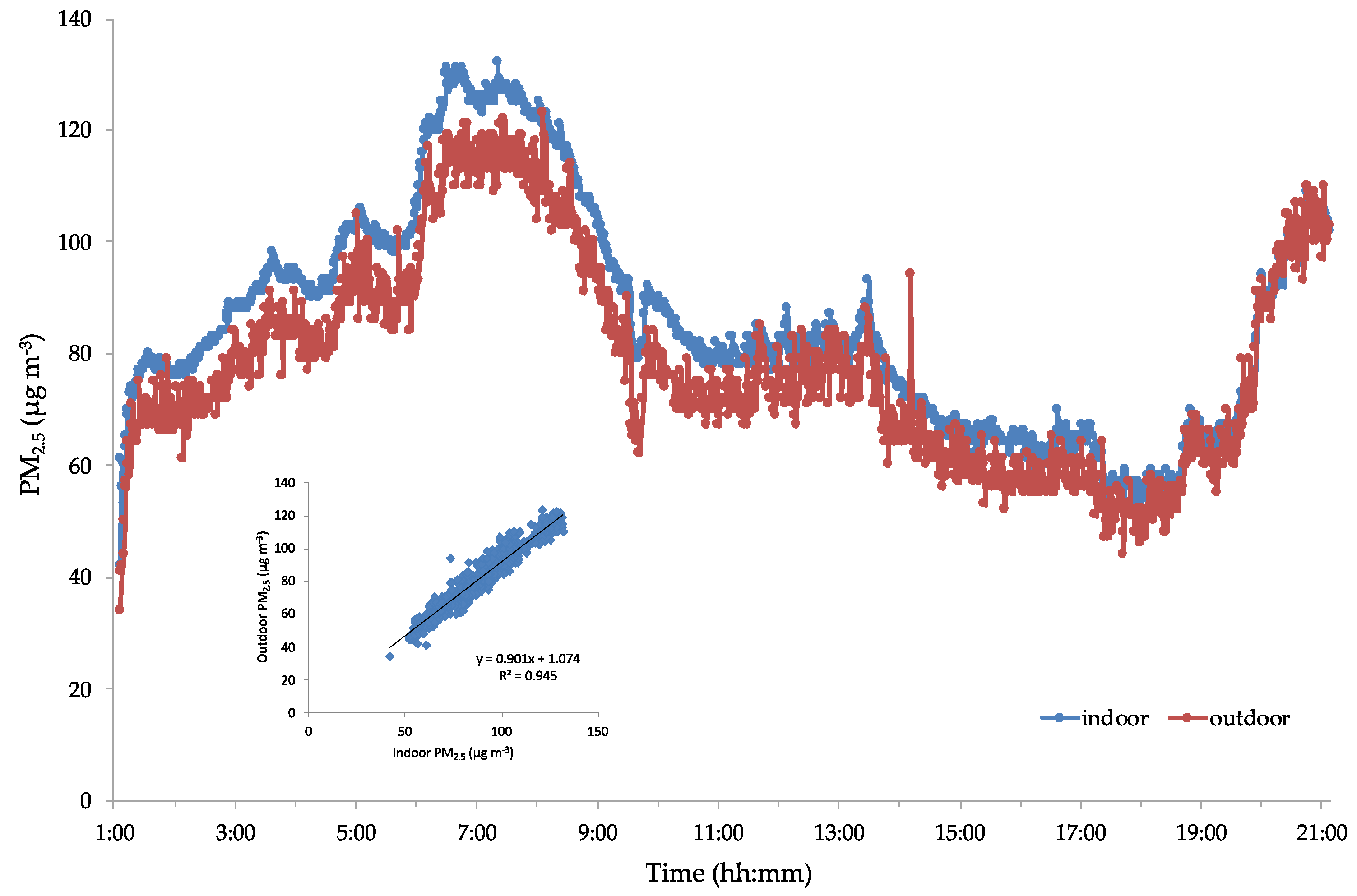
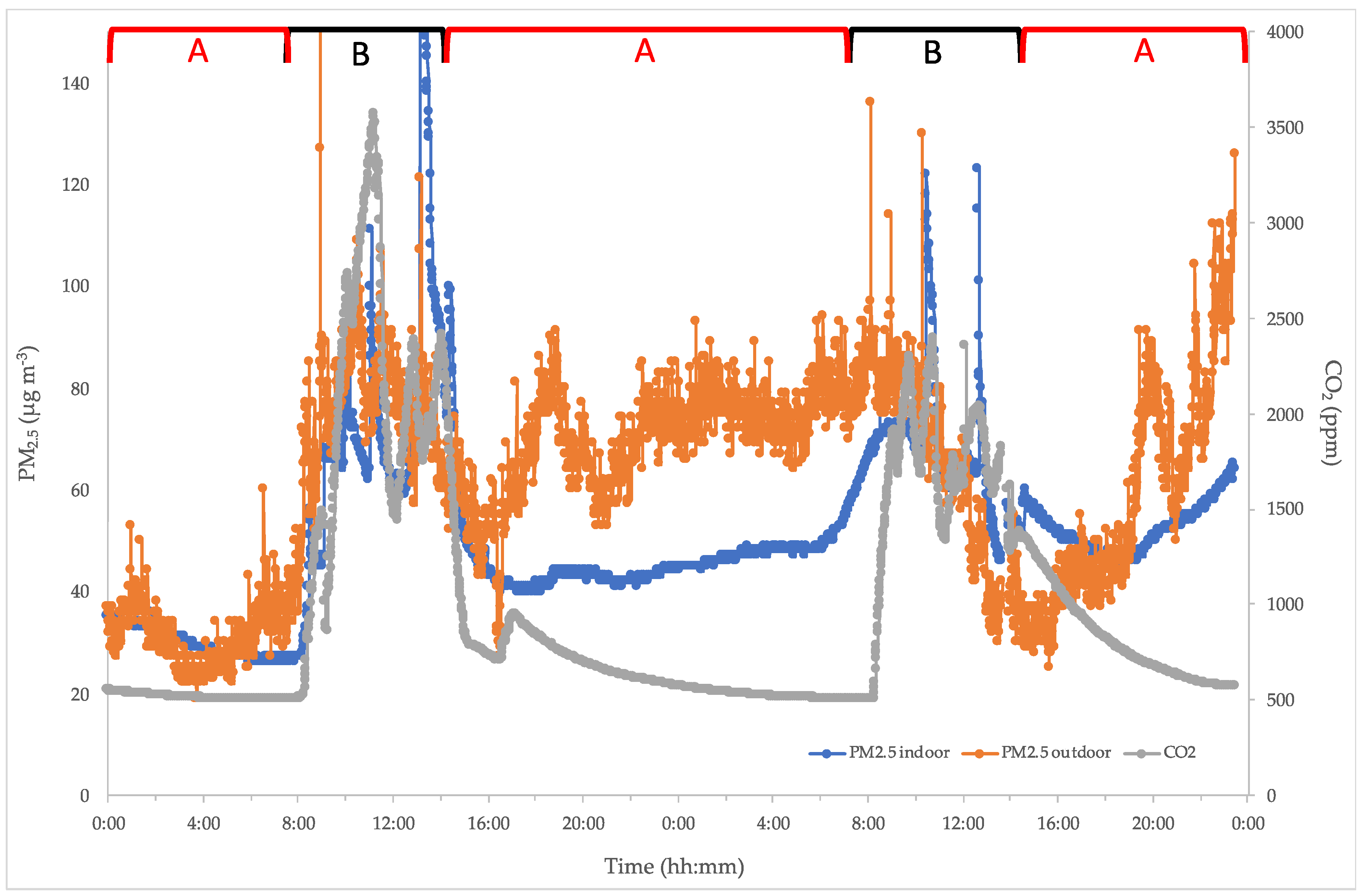
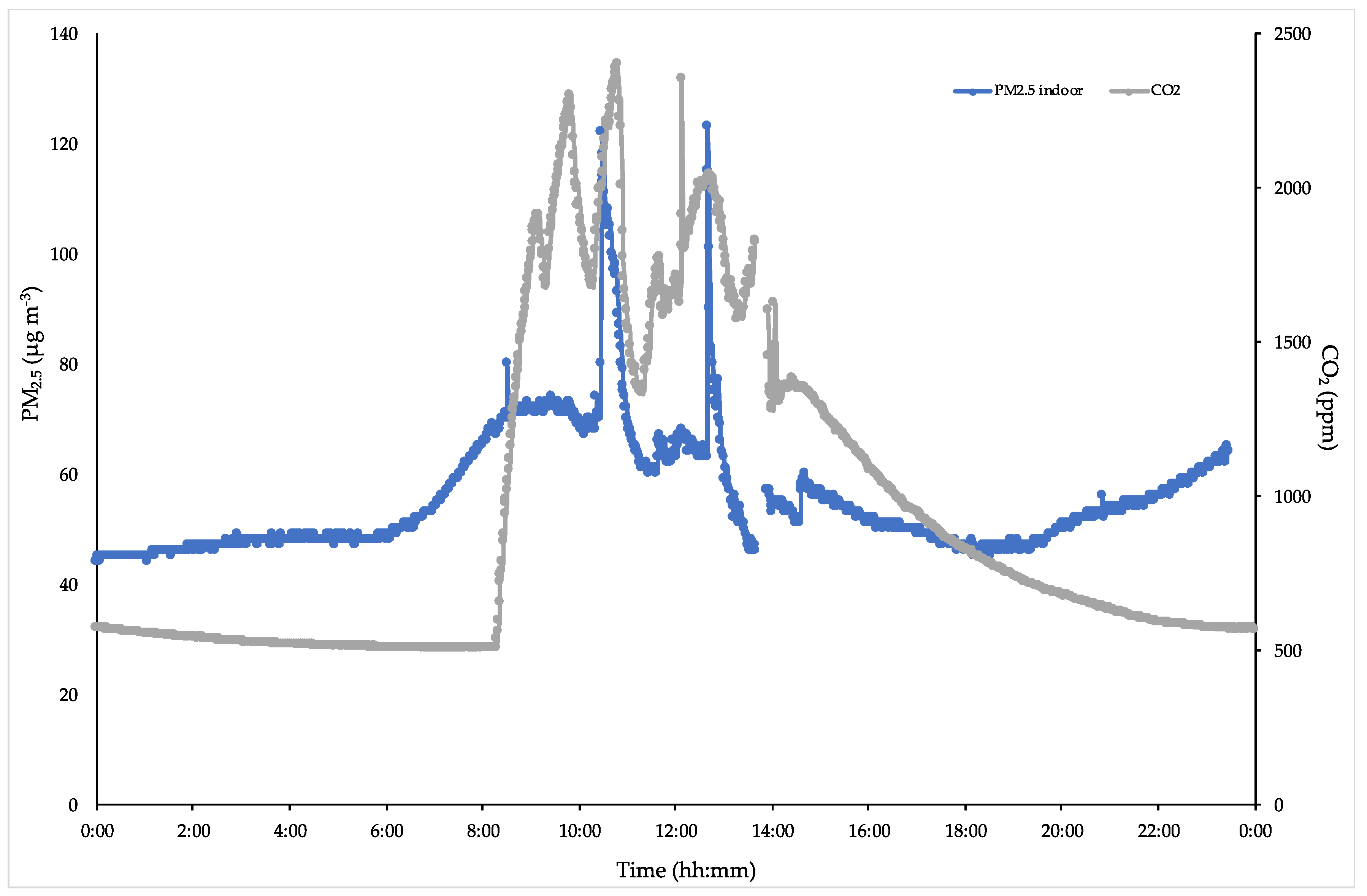
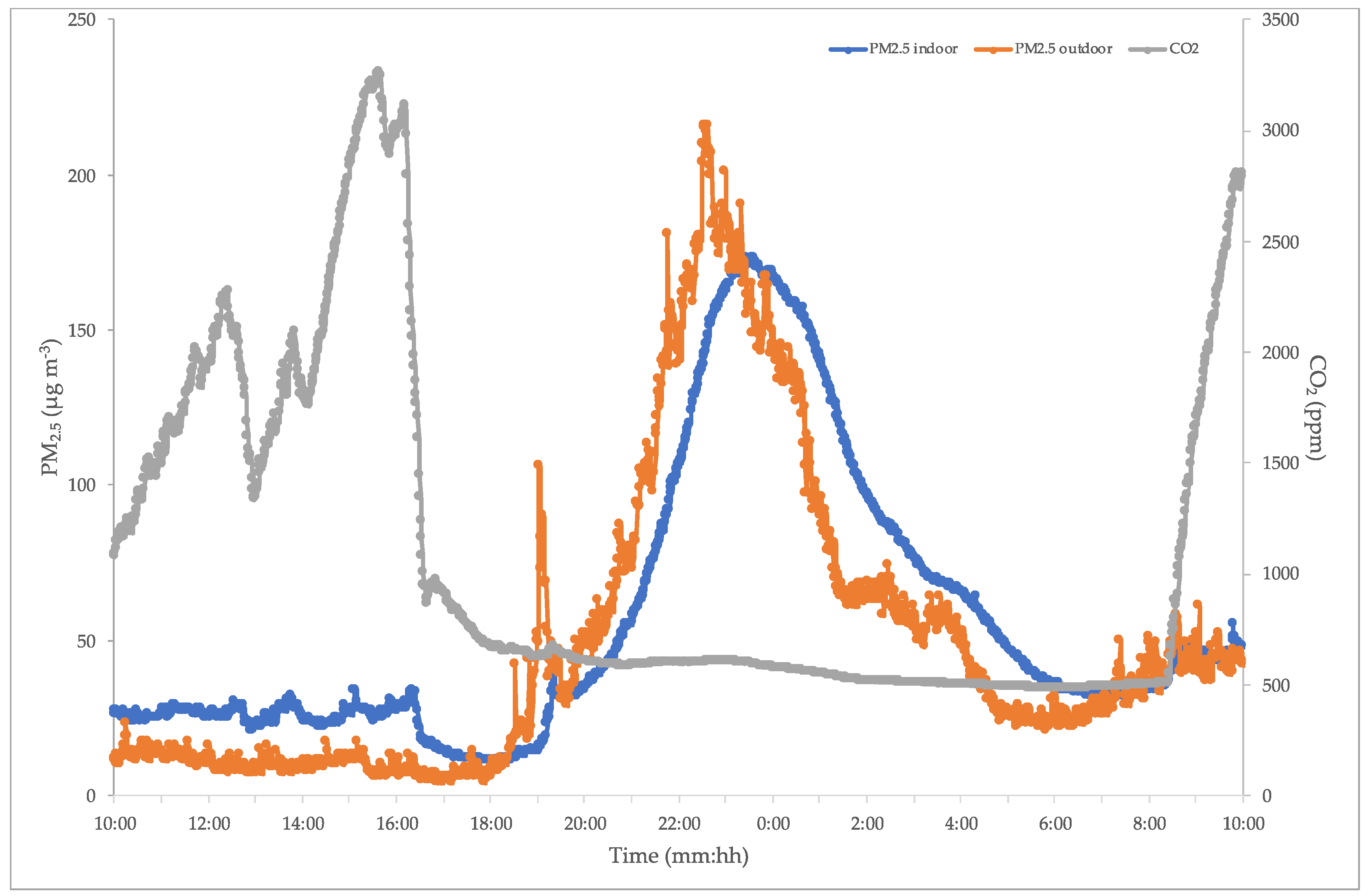

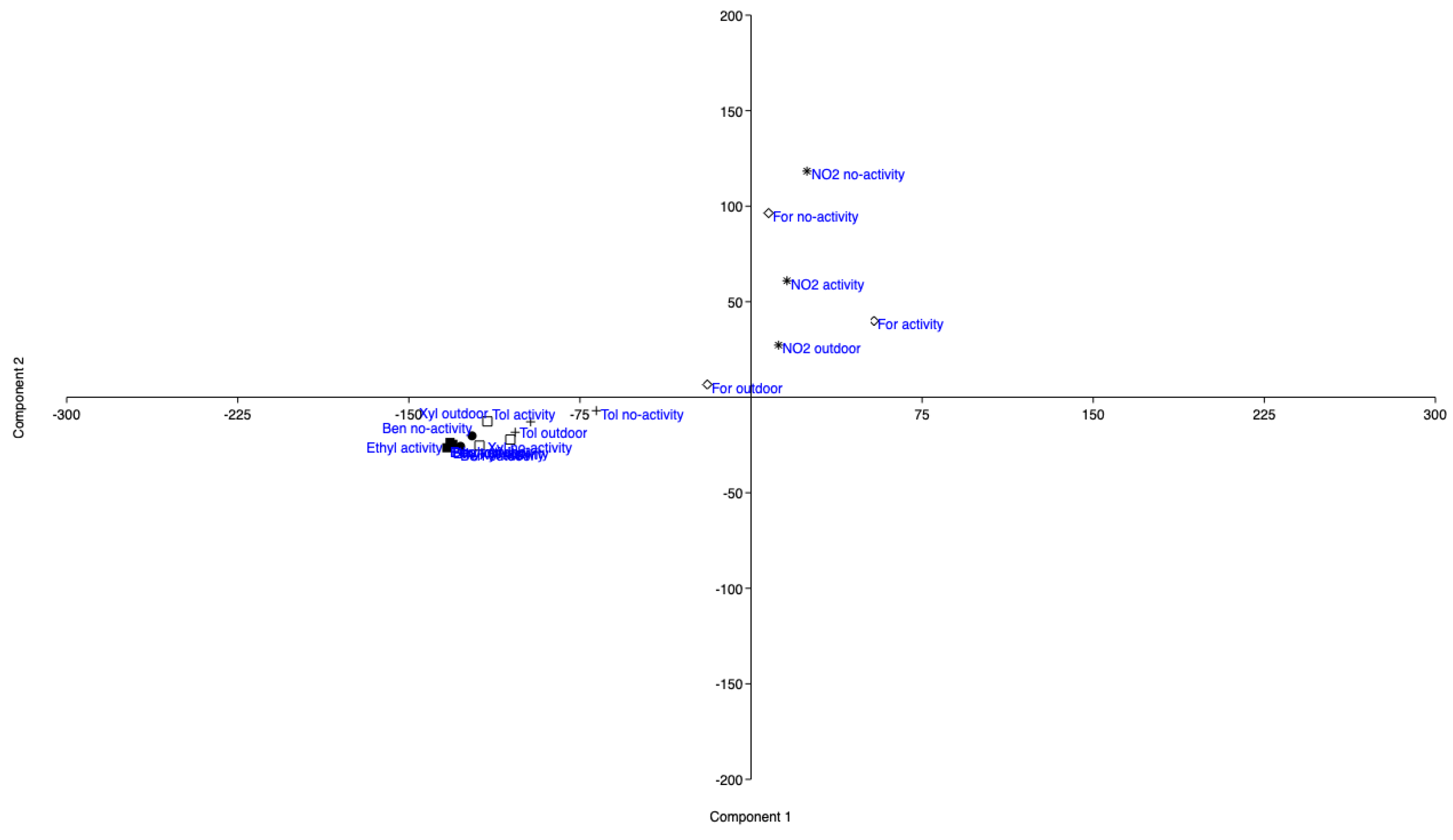
| Site | Temperature (°C) | Humidity (%) | PM2.5 Outdoor (µg m−3) | PM2.5 Indoor (µg m−3) | CO2 (ppm) |
|---|---|---|---|---|---|
| School #A | 18.9 ± 2.2 (11.4) | 53.1 ± 1.7 (3.1) | 13.9 ± 12.8 (91.9) | 18.7 ± 6.8 (36.2) | 1352 ± 940 (70.9) |
| School #B | 25.1 ± 0.9 (3.5) | 53.9 ± 3.3 (6.2) | 22.0 ± 7.8 (35.3) | 25.5 ± 10.3 (40.3) | 774 ± 352 (45.5) |
| School #C | 17.9 ± 2.0 (11.1) | 51.9 ± 4.8 (9.3) | 11.8 ± 7.3 (62.2) | 25.6 ± 17.2 (67.1) | 1086 ± 756 (69.6) |
| School #D | 19.2 ± 2.0 (10.3) | 43.2 ± 5.3 (12.3) | 30.0 ± 35.1 (116.9) | 38.6 ± 29.9 (77.5) | 1008 ± 691 (68.6) |
| School #E | 22.7 ± 0.8 (3.5) | 49.9 ± 6.4 (17.8) | 15.2 ± 8.4 (55.4) | 18.4 ± 19.9 (108.3) | 684 ± 336 (49.0) |
| School #F | 21.8 ± 2.2 (15.0) | 44.7 ± 6.7 (15.0) | 79.4 ± 62.8 (79.1) | 56.2 ± 42.3 (75.3) | 851 ± 571 (67.0) |
| School #G | 22.7 ± 0.6 (2.7) | 43.4 ± 1.1 (2.5) | 61.7 ± 35.4 (57.4) | 52.5 ± 23.2 (44.1) | 653 ± 54 (8.3) |
| School #H | 22.4 ± 4.1 (12.5) | 32.8 ± 4.1 (12.5) | 78.5 ± 44.5 (56.7) | 51.0 ± 20.9 (40.9) | 943 ± 561 (12.5) |
| Site/Activity 1 | x + s.d. 2 | Min–Max | cv% | 75th Perc. | 95th Perc. | 99th Perc. |
|---|---|---|---|---|---|---|
| School #A | ||||||
| PM2.5 activity | 18.3 ± 5.8 | 10.0–57.0 | 31.6 | 21.0 | 27.8 | 38.8 |
| PM2.5 no activity | 17.1 ± 4.0 | 13.0–34.0 | 23.1 | 18.0 | 27.0 | 31.0 |
| CO2 activity | 2386 ± 480 | 1401–3022 | 20.1 | 2759 | 2942 | 2993 |
| CO2 no activity | 599 ± 189 | 464–1653 | 31.5 | 644 | 1041 | 1171 |
| School #B | ||||||
| PM2.5 activity | 31.0 ± 2.8 | 29.0–33.0 | 9.1 | 32.0 | 32.8 | 33.0 |
| PM2.5 no activity | 23.5 ± 5.5 | 16.0–101.0 | 23.2 | 26.0 | 30.0 | 42.8 |
| CO2 activity | 1380 ± 207 | 1233–1526 | 15.0 | 1453 | 1511 | 1523 |
| CO2 no activity | 606 ± 161 | 462–1218 | 26.6 | 653 | 1032 | 1182 |
| School #C | ||||||
| PM2.5 activity | 23.4 ± 20.6 | 9.0–312.0 | 88.3 | 22.0 | 53.0 | 82.2 |
| PM2.5 no activity | 12.7 ± 17.5 | 6.0–324.0 | 137.6 | 11.0 | 32.0 | 64.1 |
| CO2 activity | 2021 ± 667 | 486–3192 | 33.0 | 2595 | 3033 | 3170 |
| CO2 no activity | 661 ± 325 | 466–2363 | 49.2 | 655 | 1354 | 2210 |
| School #D | ||||||
| PM2.5 activity | 39.1 ± 7.0 | 30.0–74.0 | 18.0 | 45.0 | 50.0 | 57.0 |
| PM2.5 no activity | 44.9 ± 14.3 | 26.0–203.0 | 31.8 | 51.0 | 62.0 | 97.8 |
| CO2 activity | 1627 ± 806 | 487–2915 | 49.6 | 2275 | 2791 | 2888 |
| CO2 no activity | 918 ± 578 | 489–2833 | 62.9 | 1174 | 2351 | 2752 |
| School #E | ||||||
| PM2.5 activity | 20.8 ± 5.7 | 10.0–38.0 | 27.5 | 23.0 | 32.0 | 35.0 |
| PM2.5 no activity | 16.3 ± 2.0 | 11.0–46.0 | 33.0 | 17.0 | 19.0 | 22.0 |
| CO2 activity | 674 ± 222 | 494–1316 | 12.3 | 710 | 1218 | 1308 |
| CO2 no activity | 535 ± 71 | 479–823 | 13.2 | 577 | 691 | 753 |
| School #F | ||||||
| PM2.5 activity | 120.9 ± 11.2 | 101.0–156.0 | 9.3 | 126.0 | 143.0 | 152.0 |
| PM2.5 no activity | 60.7 ± 18.2 | 34.0–135.0 | 30.0 | 74.0 | 89.4 | 110.9 |
| CO2 activity | 1539 ± 606 | 521–2298 | 39.4 | 2079 | 2216 | 2279 |
| CO2 no activity | 678 ± 421 | 469–2049 | 62.1 | 537 | 1735 | 2004 |
| School #G | ||||||
| PM2.5 activity | 46.7 ± 24.8 | 33.0–66.0 | 24.8 | 59.0 | 64.0 | 66.0 |
| PM2.5 no activity | 48.6 ± 24.4 | 18.0–118.0 | 50.2 | 67.0 | 94.2 | 101.8 |
| CO2 activity | 651 ± 55 | 564–845 | 8.5 | 688 | 754 | 806 |
| CO2 no activity | N/A 3 | |||||
| School #H | ||||||
| PM2.5 activity | 82.3 ± 41.2 | 59.0–411.0 | 50.1 | 79.5 | 149.6 | 264.5 |
| PM2.5 no activity | 46.8 ± 8.5 | 40.0–100.0 | 18.3 | 48.0 | 56.1 | 90.8 |
| CO2 activity | 2206 ± 633 | 858–3564 | 28.7 | 2645 | 3360 | 3515 |
| CO2 no activity | 697 ± 302 | 503–2410 | 43.3 | 751 | 1079 | 2286 |
| Pollutant 1 | School #A | School #B | School #C | School #D | ||||||||||||
| Class | 1^ 3 | 2^ | 3^ | 5^ | 5^ | 4^ | 1^ | 2^ | 2^ | 3^ | 4^ | 5^ | ||||
| Benzene | ||||||||||||||||
| OA 2 | 2.6 | 1.1 | 0.98 | 1.5 | ||||||||||||
| A | <0.02 | <0.02 | <0.02 | 0.32 | 0.43 | 0.33 | <0.02 | <0.02 | <0.02 | <0.02 | <0.02 | <0.02 | ||||
| NA | <0.02 | 0.8 | 3.1 | 0.60 | <0.02 | 3.1 | <0.02 | 1.8 | 6.3 | <0.02 | 2.7 | <0.02 | ||||
| Toluene | ||||||||||||||||
| OA | 7.9 | 6.6 | 8.6 | 9.0 | ||||||||||||
| A | 7.7 | 6.4 | 8.2 | 7.7 | 7.4 | 8.2 | 9.2 | 7.1 | 6.7 | 8.9 | 5.8 | 9.4 | ||||
| NA | 13.1 | 4.6 | 19.3 | 13.4 | 5.3 | 19.4 | 14.0 | 6.9 | 23.1 | 18.3 | 7.0 | <0.02 | ||||
| Xylenes | ||||||||||||||||
| OA | 2.6 | 3.2 | 2.9 | 2.5 | ||||||||||||
| A | 2.2 | 2.1 | 4.6 | 2.7 | 1.9 | 5.1 | 3.1 | 4.6 | 4.9 | 3.4 | 4.3 | 6.0 | ||||
| NA | 3.9 | 4.1 | 8.8 | 4.5 | 5.0 | 7.6 | 5.2 | 7.9 | 9.7 | 4.6 | 6.8 | <0.02 | ||||
| Ethylbenzene | ||||||||||||||||
| OA | <0.02 | <0.02 | <0.02 | <0.02 | ||||||||||||
| A | <0.02 | <0.02 | <0.02 | <0.02 | <0.02 | <0.02 | <0.02 | <0.02 | <0.02 | <0.02 | <0.02 | <0.02 | ||||
| NA | 0.4 | 0.5 | <0.02 | 0.4 | 0.5 | <0.02 | 0.9 | 1.6 | <0.02 | 2.1 | 1.6 | <0.02 | ||||
| Formaldehyde | ||||||||||||||||
| OA | 39.4 | 21.1 | 24.3 | 23.2 | ||||||||||||
| A | 76.6 | 62.5 | 63.2 | 83.7 | 82.9 | 95.6 | 82.6 | 65.6 | 57.4 | 84.8 | 81.8 | 92.4 | ||||
| NA | 38.5 | 38.3 | 37.4 | 46.3 | 55.3 | 59.1 | 83.7 | 40.8 | 51.7 | 113.6 | 115.8 | |||||
| Nitrogen dioxide | ||||||||||||||||
| OA | 254 | 245 | 266 | 99 | ||||||||||||
| A | 24 | 12 | 12 | 12 | 14 | 12 | 13 | 12 | 12 | 27 | 31 | 27 | ||||
| NA | 49 | 42 | 35 | 58 | 70 | 50 | 27 | 61 | 68 | 35 | 54 | 29 | ||||
| Pollutant 1 | School #E | School #F | School #G | School #H | ||||||||||||
| Class | 1^ | 2^ | 3^ | 1^ | 2^ | 2^ | 1^ | 2^ | 2^ | 1^ | 2^ | 3^ | ||||
| Benzene | ||||||||||||||||
| OA | 2.8 | <0.02 | 1.0 | 1.2 | ||||||||||||
| A | <0.02 | <0.02 | 1.2 | <0.02 | <0.02 | <0.02 | 4.2 | <0.02 | <0.02 | <0.02 | <0.02 | <0.02 | ||||
| NA | 5.1 | 5.2 | 5.3 | <0.02 | 0.9 | 2.7 | 6.5 | 5.6 | 8.1 | 0.3 | 1.5 | 4.4 | ||||
| Toluene | ||||||||||||||||
| OA | 10.1 | 3.8 | 4.4 | 4.1 | ||||||||||||
| A | 7.7 | 6.3 | 39.2 | 4.6 | 5.5 | 4.6 | 15.1 | <0.02 | 13.5 | 6.1 | 6.4 | 5.8 | ||||
| NA | 19.4 | 20.1 | 20.3 | 13.1 | 7.0 | 17.4 | 20.2 | 18.0 | 26.3 | 17.0 | 6.8 | 18.4 | ||||
| Xylenes | ||||||||||||||||
| OA | 2.2 | 2.7 | 16 | 2.3 | ||||||||||||
| A | <0.02 | <0.02 | <0.02 | 3.2 | 2.6 | 4.1 | 4.0 | <0.02 | <0.02 | 2.9 | 3.0 | 5.2 | ||||
| NA | 4.2 | 4.4 | 4.6 | 3.8 | 6.0 | 9.3 | 5.0 | 4.2 | 5.7 | 4.9 | 7.3 | 8.4 | ||||
| Ethylbenzene | ||||||||||||||||
| OA | <0.02 | <0.02 | 3.5 | <0.02 | ||||||||||||
| A | <0.02 | <0.02 | <0.02 | <0.02 | <0.02 | 0.3 | <0.02 | <0.02 | <0.02 | <0.02 | <0.02 | <0.02 | ||||
| NA | <0.02 | <0.02 | <0.02 | 0.9 | 1.2 | 0.6 | 2.1 | <0.02 | <0.02 | 0.7 | 1.0 | <0.02 | ||||
| Formaldehyde | ||||||||||||||||
| OA | 27.5 | 18.7 | 33.5 | 15.4 | ||||||||||||
| A | 55.0 | 52.5 | 51.9 | 90.9 | 82.8 | 43.0 | 34.5 | 70.6 | 81.3 | 64.8 | 70.5 | 72.1 | ||||
| NA | 36.6 | 38.2 | 35.8 | 165.2 | 40.5 | 44.6 | 45.3 | 42.5 | 51.3 | 62.6 | 56.3 | |||||
| Nitrogen dioxide | ||||||||||||||||
| OA | 133 | 226 | 143 | 344 | ||||||||||||
| A | 36 | 29 | 33 | 14 | 22 | 19 | 19 | 15 | 13 | 15 | 12 | 10 | ||||
| NA | 73 | 55 | 67 | 74 | 96 | 136 | 145 | 98 | 95 | 49 | 35 | 35 | ||||
© 2020 by the authors. Licensee MDPI, Basel, Switzerland. This article is an open access article distributed under the terms and conditions of the Creative Commons Attribution (CC BY) license (http://creativecommons.org/licenses/by/4.0/).
Share and Cite
Settimo, G.; Indinnimeo, L.; Inglessis, M.; De Felice, M.; Morlino, R.; di Coste, A.; Fratianni, A.; Avino, P. Indoor Air Quality Levels in Schools: Role of Student Activities and No Activities. Int. J. Environ. Res. Public Health 2020, 17, 6695. https://doi.org/10.3390/ijerph17186695
Settimo G, Indinnimeo L, Inglessis M, De Felice M, Morlino R, di Coste A, Fratianni A, Avino P. Indoor Air Quality Levels in Schools: Role of Student Activities and No Activities. International Journal of Environmental Research and Public Health. 2020; 17(18):6695. https://doi.org/10.3390/ijerph17186695
Chicago/Turabian StyleSettimo, Gaetano, Luciana Indinnimeo, Marco Inglessis, Marco De Felice, Roberta Morlino, Annalisa di Coste, Alessandra Fratianni, and Pasquale Avino. 2020. "Indoor Air Quality Levels in Schools: Role of Student Activities and No Activities" International Journal of Environmental Research and Public Health 17, no. 18: 6695. https://doi.org/10.3390/ijerph17186695
APA StyleSettimo, G., Indinnimeo, L., Inglessis, M., De Felice, M., Morlino, R., di Coste, A., Fratianni, A., & Avino, P. (2020). Indoor Air Quality Levels in Schools: Role of Student Activities and No Activities. International Journal of Environmental Research and Public Health, 17(18), 6695. https://doi.org/10.3390/ijerph17186695







